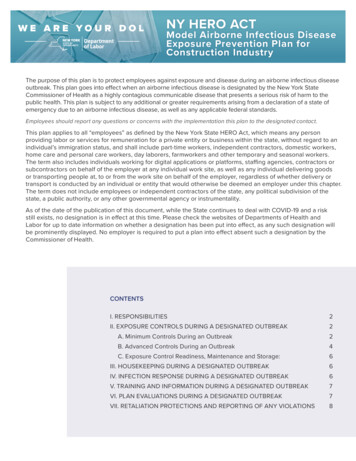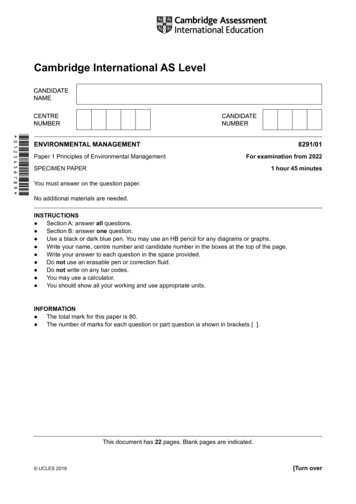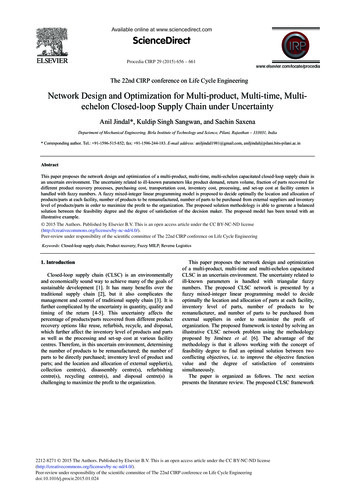
Transcription
allRAPID RISK ASSESSMENTMonkeypox multi-country outbreak23 May 2022Key messagesCases of monkeypox (MPX) acquired in the EU have recently been reported in nine EU Member States (Austria,Belgium, France, Germany, Italy, Portugal, Spain, Sweden, and the Netherlands).Monkeypox (MPX) does not spread easily between people. Human-to-human transmission occurs through closecontact with infectious material from skin lesions of an infected person, through respiratory droplets inprolonged face-to-face contact, and through fomites. The predominance, in the current outbreak, of diagnosedhuman MPX cases among men having sex with men (MSM), and the nature of the presenting lesions in somecases, suggest transmission occurred during sexual intercourse.Based on ECDC’s epidemiological assessment, the likelihood of MPX spreading in persons having multiplesexual partners in the EU/EEA is considered high. Although most cases in current outbreaks have presentedwith mild disease symptoms, monkeypox virus (MPXV) may cause severe disease in certain population groups(young children, pregnant women, immunosuppressed persons). However, the likelihood of cases with severemorbidity cannot be accurately estimated yet. The overall risk is assessed as moderate for persons havingmultiple sexual partners (including some groups of MSM) and low for the broader population.Treatment is mainly symptomatic and supportive, including prevention and treatment of secondary bacterialinfections. Smallpox vaccine can be considered for post-exposure prophylaxis of close contacts at increasedrisk for severe disease, however careful benefit/risk assessment should be performed for the exposedindividual. Important information on the use of currently available smallpox vaccines is missing for groups atincreased risk for severe disease. In addition, antivirals are potential treatment options for severe cases.EU/EEA countries should focus on prompt identification, management, contact tracing and reporting of newMPX cases. Countries should update their contact tracing mechanisms, their diagnostic capacity fororthopoxviruses and review the availability of smallpox vaccines, antivirals and personal protective equipment(PPE) for health professionals.An interim case definition is proposed for case reporting. Guidance for the management of MPX cases andclose contacts is also included. Cases should remain isolated until their rash heals completely, avoiding contactwith immunosuppressed persons and pets. Abstaining from sexual activity and close physical contact is alsoadvised until the rash heals. Most cases can remain at home with supportive care.Close contacts of MPX cases should self-monitor for the development of symptoms up to 21 days from the lastexposure to a case.Healthcare workers should wear appropriate PPE (gloves, water-resistant gown, FFP2 respirator) whenscreening suspected cases or caring for a MPX case. Laboratory personnel should also take precautions toavoid occupational exposure.Suggested citation: European Centre for Disease Prevention and Control. Monkeypox multi-country outbreak – 23 May 2022.ECDC: Stockholm; 2022. European Centre for Disease Prevention and Control, Stockholm, 2022
RAPID RISK ASSESSMENTMonkeypox multi-country outbreak – 23 May 2022Close contacts of a MPX case should be deferred from blood, organ or bone marrow donations for a minimumof 21 days from the last day of exposure.Proactive risk communication and multiple community engagement activities should be carried out to increaseawareness, provide updates and guidance to those at increased risk and the wider public. Risk communicationmessages should stress that MPXV is spread through close contact between people, especially in the samehousehold, potentially including the sexual route. A balance should be kept between informing those most atrisk but also communicating that the virus does not spread easily between people the risk to the broaderpopulation is low.There is a potential risk of human-to-animal transmission in Europe, therefore close intersectoral collaborationbetween human and veterinary public health authorities working from a ‘One Health’ perspective is needed tomanage exposed pets and prevent the disease from being transmitted in wildlife. EFSA is not aware to date ofany reports on infections in animals (pets or wild animals) in the EU.Several unknowns still exist regarding this outbreak and ECDC will continue to monitor developments closelyand update the risk assessment as new data and information become available.Event backgroundOn 7 May 2022, the United Kingdom (UK) reported an imported case of monkeypox (MPX) in a person travellingfrom Nigeria. The case reported developing a rash-like illness on 29 April 2022 and travelled from Lagos to Londonon 3-4 May. The diagnosis was confirmed by monkeypox virus (MPXV) PCR on a vesicular swab on 6 May by theUK Health Security Agency (UKHSA) Rare and Imported Pathogens Laboratory.On 13 May 2022, the UK reported two further cases of MPX who are part of the same family and not linked to thesingle imported case from Nigeria which was notified on 7 May. The cases were confirmed by PCR testing onvesicle swabs. A third family member had previously developed a rash but recovered fully. None of the individualsin this cluster had travelled or had contact with anyone with a relevant travel history [1].On 15 May 2022, the UK reported four additional cases of MPX, confirmed by PCR. None of these cases haveknown epidemiological links to the imported case from Nigeria (notified on 7 May) or to the family cluster (notifiedon 13 May). The four cases were men who have sex with men (MSM) and presented with a vesicular rash-likeillness. They were identified through attendance at genitourinary medicine (GUM) clinics. The cases are beingmanaged in high consequence infectious diseases units in the UK [1].On 18 May 2022, two additional cases (also MSM) were reported, one in London and one in the South-East ofEngland[1].On 20 May 2022, 11 additional cases were reported by the UKHSA, bring the total number of MPX cases confirmedin England to 20 [1]. All cases reported in the UK have been confirmed as caused by the MPXV West African clade.Starting from the 18 May, multiple EU/EEA Member States reported additional suspected or confirmed cases: On 18 May, Portugal reported 14 cases of MPXV confirmed by real-time PCR in the Lisbon and Tagus RiverValley Region. All cases were men with a clinical presentation of rash (some ulcerative), fever, myalgia andasthenia. None of the cases needed hospitalisation [2]. On 20 May, nine additional confirmed cases werereported, bringing the total number of confirmed cases to 23. In two cases, the west African clade was identified.On 19 May, Spain reported seven confirmed and 23 suspected cases of MPX, all among men. On 20 May, 16additional confirmed cases were reported [3]. On 22 May, seven more cases were confirmed, with 39 newsuspected cases under investigation [4].On 19 May, Belgium reported a confirmed case in a man with travel history to Lisbon, Portugal. His partnerdeveloped similar symptoms and was confirmed on the 20 May. As of 22 May, a total of four confirmed cases hadbeen reported [5,6].On 19 May, Germany confirmed its first case in a man with travel history to Spain and Portugal. On 20 May, twomore confirmed cases were reported. [7].On 20 May, France reported its first confirmed case in a man with no travel history, with three additional casesunder investigation [8].On 20 May, Italy reported one confirmed case of MPX in a man who required hospitalisation and had travelhistory to Spain. On 21 May, two further confirmed cases were reported [9].On 18 May, Sweden reported a confirmed case in a man [10]On 20 May, the Netherlands reported one confirmed case, a man with travel history to Belgium [11].On 22 May, Austria reported its first confirmed case [12].As of 23 May 2022, 67 confirmed cases had been reported in nine EU/EEA Member States and at least anadditional 42 suspected cases were under investigation.2
RAPID RISK ASSESSMENTMonkeypox multi-country outbreak – 23 May 2022Cases have also been reported outside Europe: on 18 May 2022, Canada reported two confirmed and 20 suspectedcases who were seen at sexually transmitted infection(STI) clinics, all men and currently undergoing laboratorytesting in Montreal, Quebec[13]; one confirmed case in Boston, United States, in an adult male with recent travelhistory to Canada [14] and one probable case in New York City [15]. On 19 May 2022, Australia reported twoconfirmed cases, one was a man with travel history to the UK [16]. On 20 May 2022, Israel reported a confirmedcase and additional suspected cases [17]. On 22 May, Switzerland reported a confirmed case with travel history toEurope [18].Figure 1. Geographical distribution of confirmed cases of MPX in EU/EEA countries, as of 23 May2022 (11:00)Figure 2. Geographical distribution of confirmed cases of monkeypox in non-endemic countries, as of23 May 2022 (11:00)3
RAPID RISK ASSESSMENTMonkeypox multi-country outbreak – 23 May 2022Situation in west and central Africa in 2022Generally, outbreaks of MPX continue to be reported in countries from west and central Africa [19]. Cameroonreported an outbreak of MPX in December 2021 and, as of 17 February 2022, three confirmed and 25 suspectedcases have been reported, including two deaths. Cases have been reported from countries in central, northwestern and south-western regions of the continent. Cases of MPX are sporadically reported in Cameroon, withmore than half of the geographical regions in Africa reporting at least one case between 2020 and 2022.The Central African Republic (CAR) reported six confirmed cases of MPX including two deaths on 14 March 2022.Between 1 January and 17 April 2022, 1 152 suspected cases of MPX including 55 deaths (case-fatality rate of4.8%) were reported in 54 health zones in 14 provinces of the Democratic Republic of the Congo (DRC). In theequivalent 2021 time period, 138 suspected cases and 14 deaths were reported (case-fatality rate of 10.1%).According to studies, the MPXV circulating in the DRC and CAR belong to the more virulent Congo Basin (CB) cladeof the virus.Nigeria reported 46 suspected (of which 15 confirmed) cases of MPX between 1 January and 30 April 2022.Between 2017-2022 Nigeria reported 241 confirmed cases (range 8-88 per year) including eight deaths (casefatality ratio, CFR 3.3%) [19,20].Disease backgroundDisease characteristicsMonkeypox (MPX) is a zoonotic disease and is currently the most prevalent orthopoxvirus infection in humans afterthe eradication of smallpox and the cessation of universal smallpox vaccination [21-23]. Human MPX cases areincreasingly reported in several African countries after its first identification as a human pathogen in the DRC in1970, due to a combination of factors including both increased exposure (deforestation, conflict and displacement),as well as improved surveillance and laboratory capacity in the African region [24-26].In endemic areas, MPXV is probably maintained in nature through circulation among a number of mammals,including squirrels, Gambian pouched rats (Cricetomys gambianus), striped mice, dormice and primates [25], withoccasional spill-over events to humans [27-30]. In endemic areas, MPXV is transmitted to humans through a biteor direct contact with an infected animal’s blood, meat, bodily fluids or cutaneous/mucosal lesions [21].Sequencing has identified two distinct clades of MPXV [31]. The West African clade is known to occur from westernCameroon to Sierra Leone and carries a 1% CFR, whereas the Congo Basin clade has been detected from centraland southern Cameroon to the DRC and is considered more virulent with a CFR 10% [32,33].The largest West African clade MPX outbreak identified to date was in Nigeria in 2017, with 146 suspected and 42confirmed cases [20,34]. In 2018, three unlinked travel-related MPX cases were identified in Israel, the UK, andSingapore [35-37]. These exportations represent the first time that a human host was documented to transferMPXV from the African continent. However, MPX outbreaks in animals in laboratories and zoos, with no clearlyidentified source of infection, have been reported outside the African continent [38-40].In 2003, the US Centers for Disease Control (CDC) reported a total of 81 human MPX cases after close contact withpet mammals, predominantly rodents. No human-to-human transmission was identified, and none resulted indeath. The cases were connected to the importation of small mammals from Ghana to Texas as the probablesource of introduction of the virus into the US. The spread of the virus between federal states was connected toinfected pet prairie dogs that were-housed with rodents of African origin [41].Monkeypox does not spread easily between people. Between humans, the virus can be transmitted by respiratorydroplets during direct and prolonged face-to-face contact. In addition, monkeypox virus can be transmitted bydirect contact with body fluids of an infected person, contact of mucosa or non-intact skin with open rash lesionsor with virus-contaminated objects, such as bedding or clothing [22,25]. Sexual transmission of monkeypox hasbeen described, but infrequently, in the literature. Ogoima et al. [42], in reporting the 2017 human MPX outbreakin Nigeria, hypothesised that sexual transmission was a plausible route of infection as it involved close skin-to-skincontact during sexual intercourse or transmission via genital secretions.Infection of sexual partners, both female and male, has been previously reported for vaccinia virus, another virusof the Orthopoxvirus genus, post smallpox vaccination [43,44]. Vaginal lesions occurred in the female partner of arecently vaccinated military man who removed bandages covering his vaccination site, four days after unprotectedsexual intercourse, preceded by digital vaginal contact [43]. A painful perianal rash and a lesion on the upper lipwere reported by a male patient ten days after sexual intercourse with a recently vaccinated man who did notcover his vaccination site [45]. Further transmission from this patient, while he was experiencing perianal rash,occurred in a male sexual contact who experienced general symptoms and papular lesions on his penis two daysafter sexual intercourse.4
RAPID RISK ASSESSMENTMonkeypox multi-country outbreak – 23 May 2022The incubation period for MPX is usually 6 to 13 days but can range from 5 to 21 days [25]. The illness typicallylasts for two to four weeks. Disease usually begins with fever, myalgia, fatigue and headache [36]. Within threedays from the onset of the prodrome symptoms, a centrifugal maculopapular rash starts from the site of primaryinfection and rapidly spreads to other parts of the body. Palms and soles are involved in cases of the disseminatedrash, which is a characteristic of the disease. The lesions progress, usually within 12 days, simultaneously from thestage of macules to papules, vesicles, pustules, crusts and scabs before falling off [46]. The lesions may becentrally depressed and can be extremely itchy and secondary bacterial infection may occur if scratching occurs.Lesions on oral or ophthalmic mucosa (enanthem) may also be present. Prior to and concomitant with the rash,lymphadenopathy is observed in many patients, which is usually not observed in smallpox or varicella [22,47]. Itshould be noted that the clinical manifestations in travel-related cases detected in western countries were usuallymild, sometimes with very few lesions. The onset of the rash is considered the start of the infectious period;however, it is believed that persons with prodrome symptoms can also transmit MPXV [48].The majority of human MPX cases experience mild to moderate symptoms. Complications in endemic countriesinclude encephalitis, secondary skin bacterial infections, dehydration, conjunctivitis, keratitis, and pneumonia. Thecase-fatality rate of MPX ranges from 0% to 11% in outbreaks in endemic areas with mortality mostly affectingyoung children [25]. Little information is available on MPX in immunocompromised patients. In the 2017 Nigeriaoutbreak, patients with concurrent HIV-infection had more severe morbidity with more skin lesions and associatedgenital ulcers as compared with HIV-negative individuals. No deaths were reported among HIV-positive patients[42]. Major disease sequelae are usually disfiguring scars and permanent corneal lesions [47].The route of infection (invasive, such as animal bite, vs. exposure to fomites) plays a role, with invasive modes ofexposure causing more severe disease and shorter incubation period [49].Considering varicella as the most relevant differential diagnosis, electron microscopy was traditionally used in thepast to distinguish herpesviruses from orthopoxviruses. Currently, MPXV real-time polymerase chain reaction (RealTime-PCR) on suspected skin lesions is used. Scabs, swabs and aspirated lesion fluid should be preferably used forPCR over blood due to limited duration of viremia. These samples can be transported at room temperature andwithout transport media; blood and serum for serological tests can be transported at room temperature, however,tissue biopsies should be shipped frozen on dry ice. Formalin-fixed samples can be sent at room temperature [50].Results from scabs, swabs and aspirated lesion fluid specimens show the best correlation with both infectivity andthe clinical course of infection. Recent Real Time-PCR approaches can also discriminate the two MPXV cladesdescribed above. Serology has limited value due to the immunological cross-reactivity between human-pathogenicorthopoxviruses, but it is used to monitor antibody response in vaccinated individuals. However, for contactinvestigations, IgM and IgG detection is available in some laboratories. Immunohistochemistry can potentially beused to identify antigens in biopsy samples.Treatment is primarily symptomatic and supportive (alleviation of fever and pruritus, hydration), includingprevention and treatment of secondary bacterial infections. Antivirals tecovirimat, brincidofovir and cidofovir arepotential options for severe cases [25]. Only Tecovirimat has market authorisation in the EU for the treatment oforthopoxvirus infection, including MPX. Limited data on efficacy and safety exist currently, while clinical studies areongoing in Africa [51].Previous vaccination against smallpox can confer cross-protection against monkeypox, which was estimated fromolder studies to be as high as 85% [22]. The protective effect of smallpox vaccination wanes with time, althoughserosurveys indicate that it can last more than20 years. However, it is believed that despite the waning effectsmallpox vaccine confers, lifelong protection against severe disease can occur due to memory B and T cellstherefore some degree of protection should be expected in the population of adults in the EU/EEA currently over50 years of age [52]. No vaccine is currently authorised in the EU against MPX, but early post-exposure vaccination(within four days of exposure to a MPX case) with smallpox vaccine may prevent the disease or make its courseless severe [53,54]. A third generation, non-replicating smallpox vaccine (ImvanexTM - Modified Vaccinia Ankara)was authorised under exceptional circumstances by EMA in 2013 for use against smallpox [55]. This vaccine hasindication for use in patients with HIV infection for smallpox, but currently has no authorisation for use againstMPX [56]. Earlier generation smallpox vaccines have been used for years (DryvaxTM and ACAM2000TM), howeverthey are associated with severe side effects, including cardiac side effects, and they are no longer licensed in the EU.Monkeypox virus is not considered a biological agent of concern for biosecurity according to the U.S. CDC list ofbioterrorism agents [57], while it is considered an ‘agent with high threat for deliberate release’ using the matrixdeveloped by the EU task force on Bioterrorism (BICHAT) [58]. Although the case-fatality rate of the pathogen islow, its relative environmental stability and persistence (see below) and transmission pathways, in addition to thelack of immunity in the population, the limited availability of effective treatments and vaccination, make it an agentwhich could represent a biological threat in case of accidental spill or intentional release.5
RAPID RISK ASSESSMENTMonkeypox multi-country outbreak – 23 May 2022ECDC risk assessment for the EU/EEAThis assessment is based on evidence available to ECDC at the time of publication. It follows the ECDC rapid riskassessment methodology, where the overall risk is determined by a combination of the probability of infection andthe impact of the disease on the affected population [59]. ECDC will keep monitoring the event and will reassessthe risk depending on its evolution and the implemented response measures.What is the risk of further spread of monkeypox in EU/EEAcountries?Risk in persons with multiple sexual partners, including some MSMHuman-to-human transmission of MPX occurs through close contact with infectious material from skin lesions of aninfected person, and also through respiratory droplets in prolonged face-to-face contact and through fomites. Thepredominance, in the current outbreak, of diagnosed human MPX cases among MSM, and the nature of thepresenting lesions in some cases, suggest that transmission occurred during sexual intercourse. Transmissionthrough intact skin contact is less likely but cannot be excluded. Although sequencing data are not yet available toindicate that the outbreak is the result of one introduction, the cases of MPX within parts of the MSM communitywhose sexual networks1 are inter-connected could be considered a possible source of introduction.Particular sexual practices (e.g. having multiple casual sexual contacts and/or multiple sexual partners, attendingchemsex parties) that may be present within some parts of the MSM community could further facilitate thetransmission of monkeypox. Outbreaks of other sexually transmitted infections among MSM can be linked to travelabroad and to social and mass gathering events (e.g., pride events) [60-62]. Several such events are taking placein Europe over the spring and summer months, which can contribute to further accelerate the transmission ofMPXV. In addition, smallpox vaccination, which confers cross-protection, has been discontinued since the 1980sand only a small percentage of military and frontline health professionals have been vaccinated in recent years.Therefore, a large part of the population is vulnerable to MPXV. The probability of further spread of MPXV amongpersons with multiple sexual partners in interconnected sexual networks (including some groups of MSM) inEU/EEA countries and globally, in the coming months, is therefore assessed as high.While most MPX cases reported thus far in this outbreak have been described as mild, the number of reportedcases is too low to reliably estimate rates of severe morbidity and mortality, and a clear overview of the clinicalpresentations in the reported cases is currently lacking. Severity estimates in the literature exist from endemiccountries and the 2003 USA outbreak. In Nigeria, the CFR is estimated at 3.3% for cases diagnosed between 20172022, however, it is a different health care and population setting, where the disease is endemic and is probablytransmitted through different routes (e.g., more frequent contact with animals). In the 2003 outbreak in the USA,which was exclusively driven by contact with infected pets (rodents), five out of 34 confirmed cases (15%) weredefined as severely ill, and no deaths were reported. Patients under 18 years of age did not develop severe illnessmore frequently, compared to older patients [63]. These severity estimates are probably biased upwards.Immunocompromised patients are believed to be more at risk for severe disease and the prevalence of HIV amongMSM is higher than in the broader population [64]. However, most people living with human immunodeficiencyvirus (PLWHIV) in EU/EEA (range 67–87%) are receiving antiretroviral treatment, and are not severelyimmunocompromised [65]. Moreover, some treatment options are available for severe MPX cases. Therefore, theimpact of MPX is assessed as low, which combined with the high probability of infection leads to an overallmoderate risk for persons with multiple sexual partners.It should be noted that the above-mentioned moderate risk may be higher for older people who have multiplesexual partners or people with untreated HIV infection. ECDC will reassess the risk as more information (includingclinical presentation and outcomes) becomes available.Risk for the broader populationBased on the evidence from the cases in this outbreak detected to date, overall, the probability of further spread ofMPXV among the broader population in EU/EEA countries and globally in the coming months, is assessed as verylow leading to an overall low risk for the general population. However, the individual risk for very young children,pregnant women, elderly or immunocompromised individuals among close contacts of MPX cases may be high dueto the higher impact of the disease in these groups.1Sexual networks are groups of people who are connected to one another sexually. The different behaviour of those within thegroup can, for example, affect how quickly STIs can spread through a network.6
RAPID RISK ASSESSMENTMonkeypox multi-country outbreak – 23 May 2022Risk for health professionalsHealthcare workersTransmission to HCWs exposed to patients with MPX is possible, given the risk of transmission of otherorthopoxviruses, such as smallpox, and has been reported in outbreaks in endemic countries [42,66]. In a study of57 HCWs exposed to patients with MPX, including nursing staff, radiology technicians, emergency department staffand physicians, no case of infection was documented [67]. One HCW in this study had evidence of recentorthopoxvirus seroconversion but had also received smallpox vaccination four months before being exposed. Inanother outbreak report, monkeypox was transmitted to a HCW, whose only identified exposure was the changingof potentially contaminated bedding of a hospitalised patient with MPX [35].The probability of MPX transmission to HCWs wearing appropriate personal protective equipment (a disposablegown, disposable gloves, disposable shoe or boots covers, respiratory protection (Filtering Face Piece (FFP) 2respirator), and eye splash protection (goggles or visor) is very low, with the disease having an estimated lowimpact, leading to an overall low risk.The risk to HCWs with unprotected close contact with MPX cases (e.g. contact face-to-face for prolonged time,contact with open lesions without gloves, intubation or other invasive medical procedure) is assessed as moderate,equivalent to that of a close contact.Laboratory personnelOccupational exposure and infection from orthopoxviruses have been occasionally reported among laboratorypersonnel handling virus-containing specimens [68,69].The risk of occupational exposure is estimated to be low for trained laboratory personnel following appropriatebiosafety procedures [70].Unprotected occupational exposure in a laboratory, particularly involving spillage or aerosolisation with exposure ofmucosa, carries high probability of infection and moderate risk of the disease (due to the direct exposure ofmucosae to potentially significant quantity of virus). The risk for unprotected laboratory personnel is assessed ashigh.Due to an expected higher impact, the risk may be higher for exposed HCWs and laboratory personnel who areolder or immunocompromised.Table 1. Summary of risk assessed for the different population categoriesHealth professionalsPersons withmultiple sexualpartners, includingsome MSMBroaderpopulationProbabilityHighImpactOverall riskHCWsLaboratory personnelProperPPEUnprotectedexposureProper procedure andPPEUnprotectedexposureVery lowVery lowHighVery teLowHighThe risk may be higher for certain people in some of the above categories, particularly very young children,pregnant women, elderly, or immunocompromised persons.Risk of transmission through substances of human originNo cases of monkeypox virus transmission through substances of human origin have ever been documented.However, there are reported cases of virus transmission from mother to child during pregnancy [71], and animalstudies show the presence of virus in blood, tissues and organs of infected animals.[72,73] Existence of viremia(i.e. blood specimens positive for viral DNA) has been shown. The duration of viremia is unclear [74], and thereare no data on viraemia in asymptomatic patients (including during the incubation period). Even thoughinformation is limited, it is likely that monkeypox virus is transmissible through substances of human origin, but theoverall risk for recipients in the EU/EEA is low.7
RAPID RISK ASSESSMENTMonkeypox multi-country outbreak – 23 May 2022Risk of spill-over event to animal species in EuropeCurrently, little is known about the suitability of European peri-domestic (mammalian) animal species to serve as ahost for monkeypox virus. However, rodents, and particularly species of the family of Sciuridae (squirrels) are likelyto be suitable hosts, more so than humans (see disease background), and transmission from humans to (pet)animals is theoretically possible. Such a spill-over event could potentially lead to the virus establishing in Europeanwildlife and the disease becoming an endemic zoonosis. In the US, there is no evidence that the virus becameenzootic in wildlife, however, animal health authorities carried out systematic surveillance and an aggressivecampaign for exposed animals during the 2003 outbreak [41]. The probability of this spi
The largest West African clade MPX outbreak identified to date was in Nigeria in 2017, with 146 suspected and 42 confirmed cases [20,34]. In 2018, three unlinked travel-related MPX cases were identified in Israel, the UK, and










